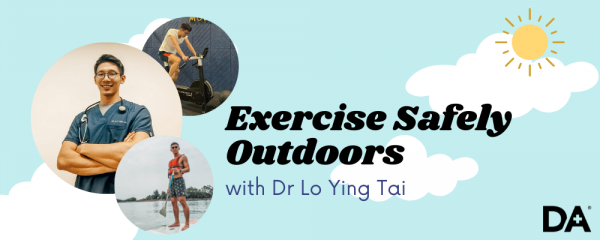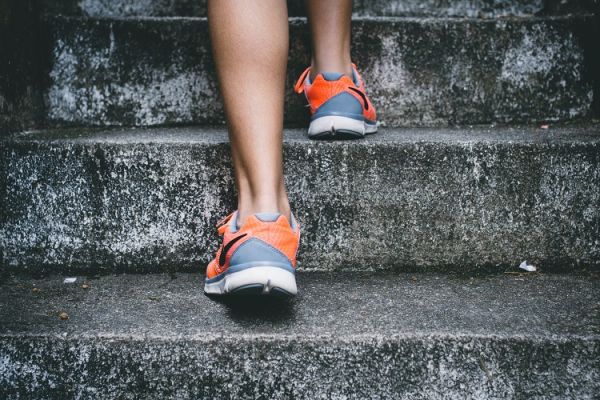On top of giving us some fresh air, exercising outdoors has many benefits! This includes enjoying a mental health boost; getting your Vitamin D intake for the day; and burning more calories.
Dr Lo Ying Tai shares his top tips on how to start exercising outdoors safely. Apart from being an anchor doctor at the DA Clinic Group, Dr Lo is also an avid athlete, who does a variety of sports. Learn how to enjoy your time exercising outdoors, without getting injured.

Warm-ups should be at least 10 – 20% of your total workout time.
When we first reach the park, we may be tempted to rush onto the trail and get moving. However, this may result in injuries if our body isn’t ready for the exertion yet. Warms ups are especially important if you’re thinking of going to run on a trail or go road-cycling.
“A slow jog or a brisk walk is always a good way to warm up for any kind of exercise,” suggests Dr Lo. “You can also do some dynamic stretching, before you work out.”
Dynamic stretches are better than static stretches because they help to gradually raise your heart rate, before you plunge into the proper workout. Examples of dynamic stretches include:
- Jumping Jacks
- Lunges and Squats
- Arm Rotations
For Dr Lo, his warm-up routine changes, depending on his workout.
- For cardio: 400m slow jog, followed by targeted muscle stretching (such as: hamstring stretch, calf stretch, high knee taps, and tuck jumps)
- For lifting: Stretch out lower back and hamstrings, followed by unweighted deep squats, as well as a ‘modified easy version’ of his workouts. “For example, if I’m going to do weight squats, I’ll do a few unweighted squats first then build up the weight progressively.”
Consistency is key

“Exercise is an important way to take care of our health. But it can cause more harm than good, if done improperly,” says Dr Lo. If you are new to exercising outdoors, give yourself some time to get used to your new routine.
Whether it is doing a 5km trail run at MacRitchie or hiking up Bukit Timah Hill, go at your own pace so that your body can get used to the new activity. Pushing yourself too hard may result in injuries, such as sprains and strains, or muscle and joint injuries.
What is most important is consistency. By being consistent with your exercise regime, you will eventually build up your stamina and be able to tackle more intense exercise challenges.
“To help build consistency, you can plan out a training schedule. Your workouts should progressively increase in intensity and frequency, over a period of weeks or months,” shares Dr Lo. “Using a wearable can also help you to track how much effort you’re putting into your workout. We should aim to hit about 85% of our max heart rate during intense workout sessions, to improve our stamina.”
To calculate your maximum heart rate, subtract your age from 220.
Workout gear should be comfortable and suitable for the activity you’re doing
Pick sweat-wicking breathable fabrics for your workout clothes, that help your sweat to evaporate faster. Cotton is also a good option, as the material is highly absorbent.
In general, your clothes should be loose and comfortable, to allow freedom of movement. “Although not so loose that it catches in your bicycle’s wheel when you’re cycling at Pulau Ubin!”
For shoes, wear shoes that are built for the exercise you are doing. “For example, you shouldn’t be doing a run while wearing badminton court shoes,” says Dr Lo. “You may end up with aching feet and even shin splits, if you do.”
Your shoes should also fit well. A properly fitting shoe would feel snug in the heel and mid-foot, with some wiggle room around your toes.
Caught in between two shoe sizes? Try Dr Lo’s pro-tip: “Use socks of different thickness to fine-tune the fit of your shoes.”
Eat something light and carbohydrate-rich before exercising
Always eat something before exercising, so that you can make the most of your workout. Depending on what you eat, have your meal at least 30 minutes – 2 hours before your workout.
“Try a granola bar or a banana,” suggests Dr Lo. “If you plan to do some strength training, you can also add in some protein, such as Greek yoghurt or hard-boiled eggs.”
Make sure to protect yourself from the heat

As we all know, it is always hot and humid in Singapore. Humidity prevents sweat from evaporating effectively, to cool the body. As such, it may increase the risk of heat exhaustion or heat stroke, especially when you are doing physical activity outdoors.
To protect yourself from the heat, Dr Lo’s advice is:
- Hydrate yourself adequately before and during your workout. For example, if you are walking a trail, make it a game to take a sip of water every time you hit a 1km distance marker, so you don’t forget to drink up.
- Apply sunblock generously before leaving home. Sunburnt skin affects your body’s ability to cool itself.
- Exercise at cooler times of the day, if possible. You can wake up earlier in the morning before the Sun rises or head to a park in the evenings.
Additionally, if you’re on medication, it is best to consult a doctor before exercise, as some medication may increase the risk of heat strokes.
Remember to include these tips into your workout routine before you head outside for your next adventure! You can also check the crowd level at a park, to make sure the venue isn’t too crowded when you’re going over.
Visit our in-app Marketplace, for a variety of delicious and healthy pre-workout foods as well as supplements that will help you hit your fitness goals.







